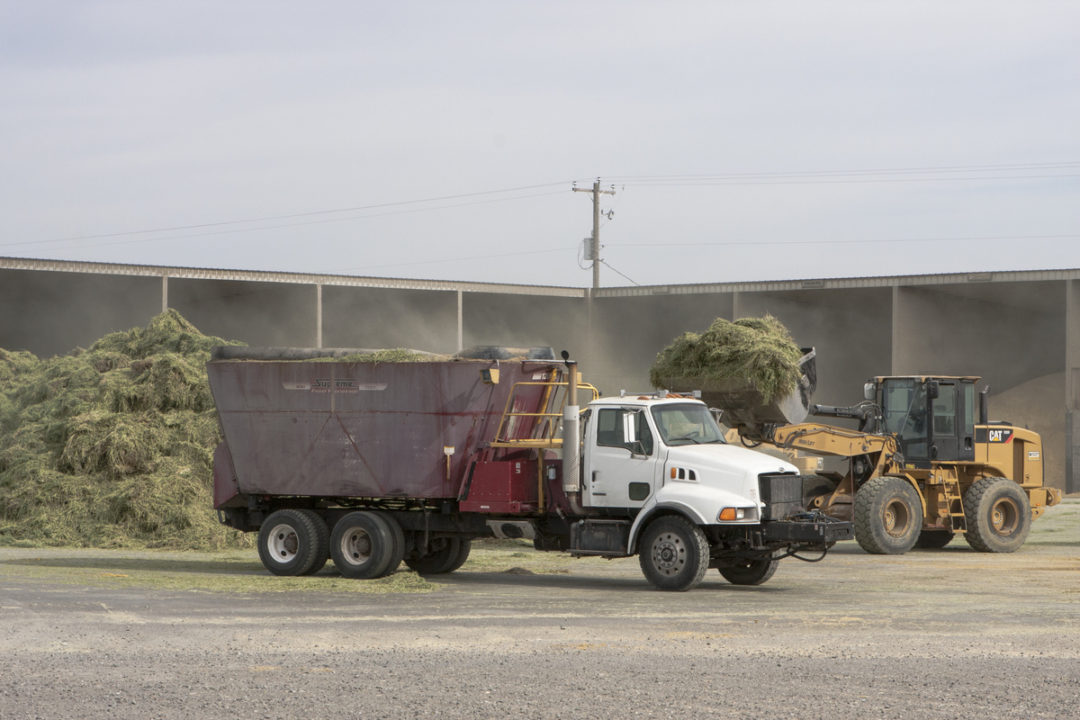The value of visibility
One aspect of a wheel loader that can greatly increase safety is good all-around visibility. Visibility from the operator’s perspective is important, including in front of, behind and to the sides of the wheel loader. Today’s wheel loaders are designed and built with better visibility features to operate as safely as possible.
Some brands of wheel loaders feature floor-to-ceiling windows, making it easier for operators within the cab to more clearly see other workers, animals and structures, and for people on the outside to see the operator within the cab. This can be especially helpful during winter, as heavy snowfall can make it harder to see one’s surroundings. Operators also have better visibility to the attachment when they are working, particularly when loading material in the bucket and dumping it into a mixer.
Manufacturers today put an emphasis on lighting, increasing visibility by installing the highest bulb possible in their machines. On a dairy operation, wheel loaders can be working all hours of the day or the night, in low-light situations and going in and out of buildings. LED lights are also useful when clearing snow from driveways, parking areas and roadways. Some manufacturers offer additional lighting kits and rotating beacons for enhanced lighting and visibility.
The rearview camera is another key safety feature that’s becoming standard equipment on many of today’s wheel loaders. With a rearview camera, operators can be sure they are safely maneuvering around any object, animal or person within their line of sight. The camera view can be seen on the LCD monitor in the cab by simply pressing a button to activate the feature. Some brands have increased the camera’s field of view or have included sensors to alert the operator when they are about to hit something.
Motion detection
Motion detection improves safety by enhancing awareness of the operator’s work area. It’s especially useful for machine blind spots – for wheel loaders, these are mainly at the back. Whether working next to people, animals or objects, blind spots can be detrimental, and motion detection ensures safety for all three.
Motion detection sensors emit a sound to alert the driver when they are about to bump into an object. The sound may get louder or more frequent the closer the machine gets to the object. The sensors are often supported by a camera that allows the operator to see what’s behind them as they are reversing.
Some brands feature motion detection that provide five warning levels to indicate the nearness of an object about to be hit. The warning levels change with the speed of the wheel loader, reducing the risk of false alarms. For example, if a wheel loader is moving at a faster speed, the warning level will get louder the closer the loader gets to the object. This ensures an operator doesn’t accidentally miss or ignore an alert.
Entering and exiting the cab
Since wheel loaders are often used for snow removal, operators should take time to clear off the steps of the machine before entering or exiting. This is especially important during icy conditions, as ice may be harder to spot on steps than snow.
Operators should use three points of contact when entering and exiting the cab. Additional grab bars may be available from some wheel loader manufacturers. It’s best to check with a local dealer and inquire about what options are available for your wheel loader.
It’s a good idea for operators to routinely perform a machine inspection, especially during winter. Snow and ice should be removed from the attachment before work begins. If possible, wheel loaders and attachments should be stored inside a building to minimize exposure to the elements. If the machine must be left outside, operators should try to park the machine next to a building and away from direct wind and precipitation. Following these steps can help prevent operator falls due to wet and slippery surfaces and minimize ice and snow buildup.
For the good of their customers, it’s important for companies to design their wheel loaders with safety in mind. With the proper safety features in place, wheel loader operators are better able to complete their work without worry.







